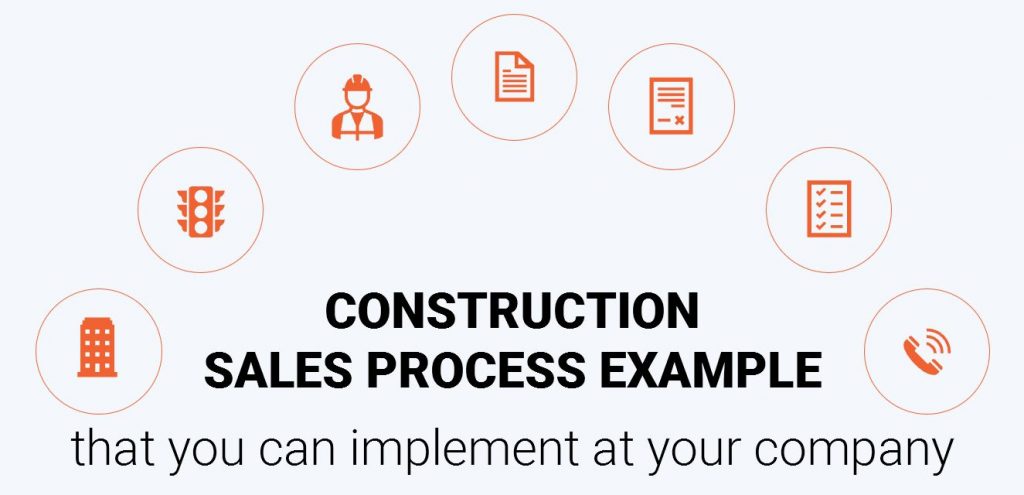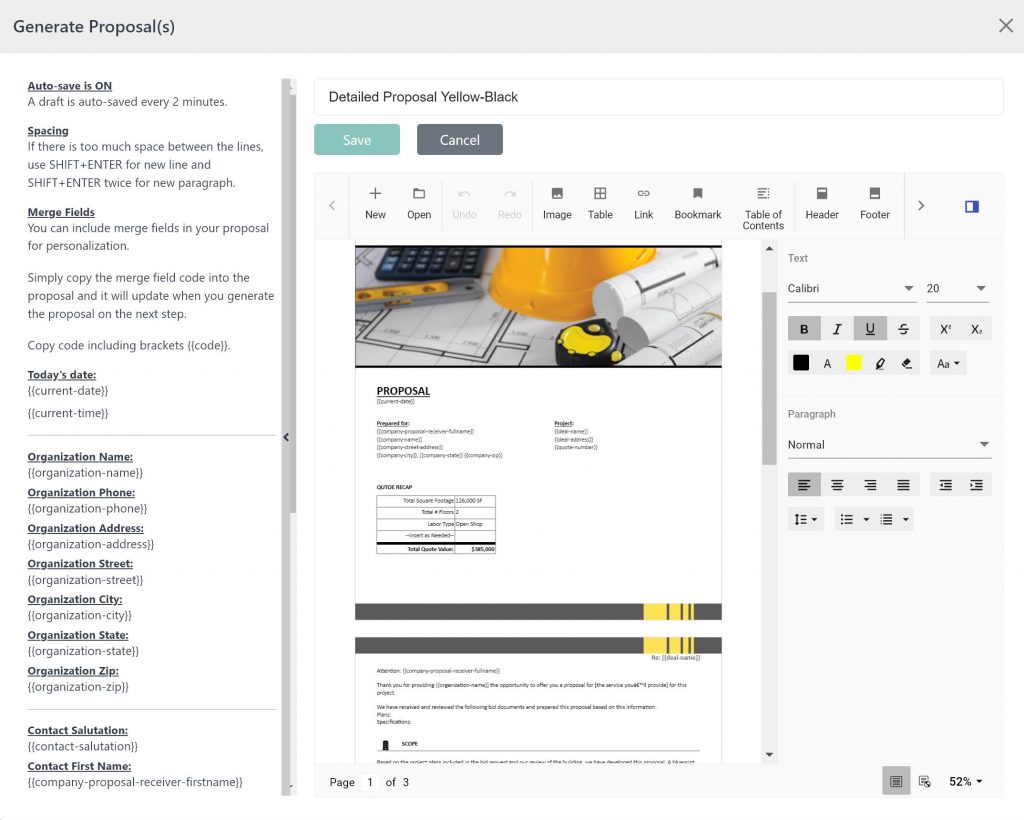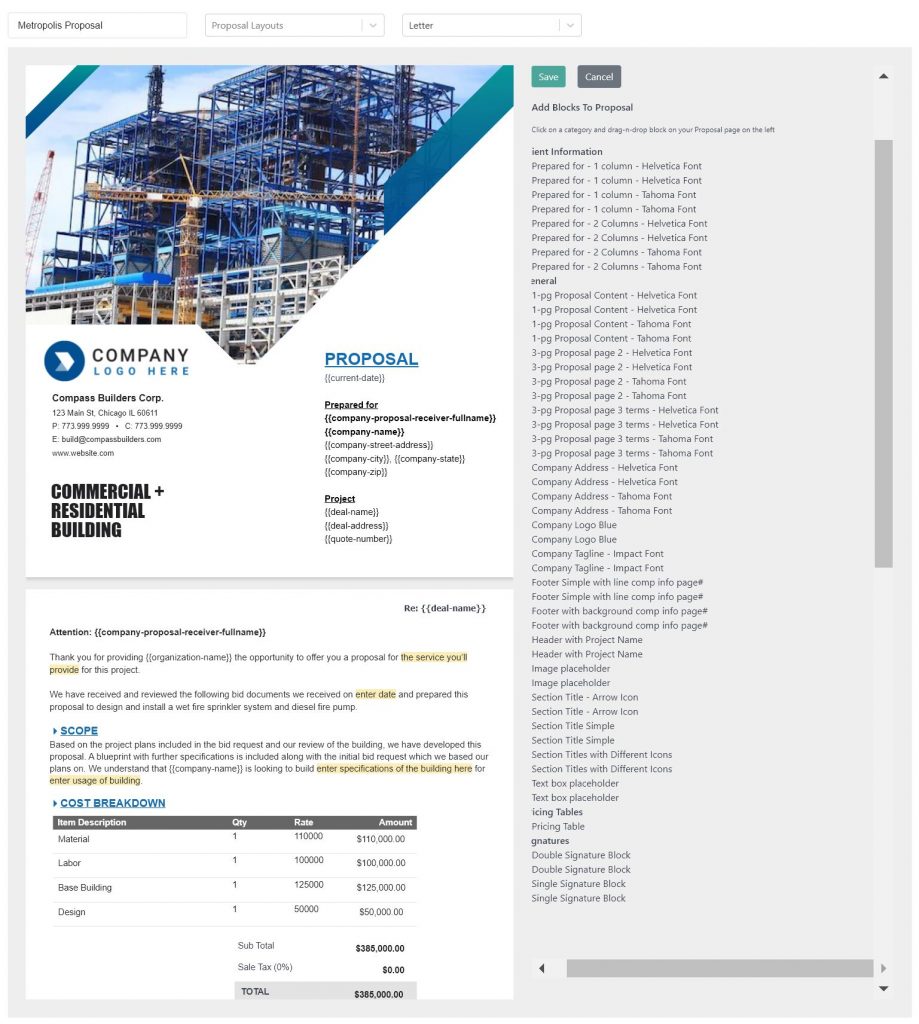The Importance of Defining Clear Construction Sales Process Steps
Processes are an integral part of running any business. A construction sales process, like all internal processes, drives consistent behavior. The sales process steps provide a framework for how an organization will achieve its goals and objectives. They allow leaders to delegate tasks and responsibilities to employees, who can then follow a series of guidelines to complete their work. Processes help ensure that the right things are being done, and in the right way. They provide structure and discipline, which can help an organization scale and grow.
A sales process in construction promotes efficiency on your sales team. When a lead comes into the pipeline, it should flow systematically through the organization so all necessary steps get done consistently each time.
The more organized your construction sales team is, the more successful it will become running on its own while growing and supporting the administrative and operation side of your business. This also allows construction business owners to scale their business and prepare them for successful exits.
ARE YOU LOOKING FOR AN EASY WAY TO BUILD YOUR CONSTRUCTION SALES PROCESS?
DOWNLOAD A CONSTRUCTION SALES PROCESS EXAMPLE THAT YOU CAN IMPLEMENT AT YOUR COMPANY

Construction Sales Process Definition
A construction sales process is a series of steps taken by a salesperson to generate leads and close jobs. It defines the steps salespeople must take to reach their goals. It is used as a blueprint that salespeople follow to generate new sales and close opportunities. A well-defined construction sales process with clear sales process steps helps salespeople become more efficient and effective. On the flip side, a poorly defined sales process will limit the potential of your sales team and inhibit the growth of your company.
This article provides an overview of the typical construction sales process, including the steps involved in lead generation, qualification, and closing a sale.

The 7 Construction Sales Process Steps
Step 1: Capture It
The construction sales process begins with identifying new business opportunities. And what’s important is that you capture those leads or opportunities in a system that’s accessible to the entire sales team.
Let’s differentiate here between prospects and opportunities. A prospect is a potential client, a company or person you’ve never worked with before. If you are a business developer, then you take that new lead or prospect and you work it until you receive an opportunity. This means you receive an invitation to bid (ITB) or a request for pricing (RFP). Once you receive an opportunity from the prospect/lead, you can move it to your list of clients. Some commercial construction companies choose to not move a prospect to their list of clients until they win an opportunity with them.

Once an opportunity comes in from a phone call, email, inquiry, or manual scrubbing and mining… capture it! In an Inbox folder, a spreadsheet, or a lead management software. Whatever data storage form works for you and the size of your company.
Step 2: Prequalify It
Should you bid everything that comes in? No, you shouldn’t.
The next thing you should do when an opportunity presents itself, is prequalify it. You prequalify opportunities based on the services and products you provide, geographical area you operate in, and available resources and manpower.
In construction, a lot of times, opportunities come through from existing clients. In these cases, and if you have enough resources available, you may want to skip the pre-qualifying step. But if you don’t have a relationship with the prospect and this is a new opportunity, you should have a designated person who does this prequalification step.
Step 3: Assign It
Once you decide to bid the opportunity, assign it. Who you assign it to depends on how your organization is set up and the system used. If an estimator creates the take-off, estimate, proposal, and sends it out, then you assign it to that estimator. If you separated account management from estimating and sales, then assign the opportunity to a team, each person with their own role. For example, you can assign an account manager, an estimator, and a construction sales rep to it.
ARE YOU LOOKING FOR AN EDITABLE DIAGRAM TO BUILD YOUR OWN SALES PROCESS?
DOWNLOAD A CONSTRUCTION SALES PROCESS EXAMPLE THAT YOU CAN IMPLEMENT AT YOUR COMPANY

STEP 4: Take-Off
The next step is to do the take-off. A take-off is a list of material needed to complete the project. The salesperson, estimator, or the designated take-off person will take care of that depending on the type of opportunity. If it’s a new construction job, your estimator will usually do the take-off. If it’s a project that needs to be surveyed in the field, sometimes the estimator will do all that. But if you have enough opportunities that require surveying, you can dedicate a person to it. What’s important is that you define a clear take-off process as part of your construction sales process. Because, regardless of who does the take-off, you want consistency and integrity with everyone’s take-offs on all opportunities.
STEP 5: Estimate
The next step in your sales process for construction is putting together the estimate. Having an estimating system is crucial to obtain consistent, accurate estimates every time. Edge Estimating, InEight Estimating Software, and ProEst from AutoDesk are all great examples. With an estimating solution, no matter which estimator puts the quantities in, the price will always come the same because it’s got consistent units of production. This level of accuracy is necessary in the competitive construction landscape.
STEP 6. Proposal
Putting together the proposal is what all the previous prep work was for. If it’s a bid, you could just fill in some blanks, put your number on it and send it out. But if you’re more relationship focused, you’re going to want to craft the proposal in more of a presentation format. And you want your proposal to stand out in the pile, especially in commercial construction.
This step of your construction sales process is as important as the other ones. Simply having a low number is not sufficient anymore these days.
You can also use a tool like Microsoft Word to create proposals. You won’t be able to generate more proposals at once, but with the right construction proposal templates, you can somewhat streamline the proposal creation process.
The best solution is a proposal generating software like iDeal Construction Proposal Software. With this type of software, you can usually store multiple proposal templates and generate multiple proposals at once. And expedition in this step of your construction sales process is a bonus.
Word Proposal Generator Software

HTML Proposal Generator Software

STEP 7. Follow-up
What happens after you send out the proposal? Your construction sales process doesn’t end with the proposal. If it does, you’re missing out on closing opportunities.
Most of the time, construction opportunities are not a one-call close, especially in the commercial construction space. You may have some one-call close opportunities on the residential or service side, but not all are like that.

Ask for Permission to Follow Up
So, what do you do after you sent out your proposal? You follow up! This is the last step in your construction sales process that ensures you maximize your chances of closing the deal. You call your prospect or client and ask, “When is the most appropriate time for me to call you back, or communicate with you again, or follow-up with you again? And what’s the most effective way? Would you like me to text you, call you, email you?”
Communication and having a clear future moving forward is crucial in closing that deal. This is critical because the construction sales rep is now still in control of this future for the most part. From the client’s perspective, if they are interested and held accountable to those next steps, they will be impressed by your professionalism. When you ask permission and you follow up when you say you’ll follow up, your credibility goes up. When you don’t, your credibility goes down.
Remember, 80% of sales are made on the 5th to 12th contact. Companies who perform follow-up close significantly more work than companies who don’t. When you adopt a follow-up routine, your salespeople are in control. They’re not a “Quote and Hope” salesperson anymore. They are in control. 48% of all salespeople don’t follow-up. You want to be in the other 52% because they close significantly more work.

How to Support and Improve your Construction Sales Process with iDeal Construction CRM
As we discussed above, having a clearly defined construction sales process is crucial to the success of your organization. And arming your sales team with a software tool that fits that sales process to a “T” will help them stay organized and in control of their activities. When salespeople are empowered with the tools and data they need to sell and track their sales against their quota, they are more likely to reach it.
For construction sales teams, the best way to capture leads and opportunities, and move them through the pre-qualifying, estimating, proposal and follow-up stages is by using a construction CRM. Even though small companies may think that spreadsheets are a good enough solution, they lack crucial functionality and robustness. In today’s digitized world, it is quite fast, easy, and inexpensive to implement a software system.
Let’s take some of the iDeal Construction CRM features and see how it supports each of the construction sales process steps.

- With iDeal Leads Management you can capture and track all your leads, regardless of source
- As your salespeople enter opportunities and move them through the different stages of the funnel, you can track actual sales against their sales goals.
- When you’re ready to create proposals, you can use the iDeal Construction Proposal Software to quickly and easily generate proposals with just a few clicks. Even multiple proposals at once. All the fill-in-the-blank data about the client and project is automatically pulled from the database at the time you generate the proposals.
- Following up on your opportunities is a breeze with the iDeal Follow-up Tool that follows the way construction salespeople need to follow-up on opportunities.
- Construction sales people can easily track sales quotas. You can set a different quota and profit target for each salesperson.
- Construction reporting on personal and overall win rates, quota tracking, margin analysis, and forecasted revenue help you keep in check and fine tune your construction sales process.
- Pricing is very affordable – if you’re looking for a sales management software free of charge, iDeal CRM is the solution for you. This way you can test drive all the features at your own pace without incurring any fees or obligations.
Set Up Your Construction Sales Process with iDeal CRM
See the iDeal Construction CRM Sales System in Action.
In Conclusion
The construction industry is a complex, multi-faceted industry that requires several different skills to be successful. The construction sales process is an integral part of any construction company. If clearly defined, the sales process steps salespeople to identify prospective customers and opportunities, understand the needs, analyze those needs against available resources, and provide the best service possible. If you haven’t implemented a construction sales process yet, it is time that you do so.
Wishing you more leads, clients, and jobs going forward!

